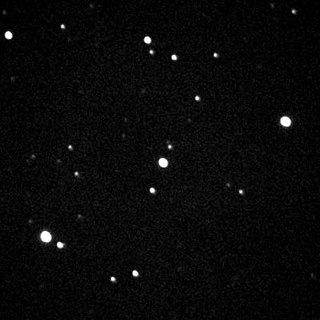Related Research Articles

XO-1 is a magnitude 11 G-type main-sequence star located approximately 530 light-years away in the constellation Corona Borealis. XO-1 has a mass and radius similar to the Sun. In 2006 the extrasolar planet XO-1b was discovered orbiting XO-1 by the transit method using the XO Telescope.

WASP-1 is a metal-rich magnitude 12 star located about 1,300 light-years away in the Andromeda constellation.
WASP-2 is a binary star system in the Delphinus constellation located about 500 light-years away. The primary is magnitude 12 orange dwarf star, orbited by red dwarf star on wide orbit. The star system shows an infrared excess noise of unknown origin.
WASP-6, also officially named Márohu, is a type-G yellow dwarf star located about 651 light-years away in the Aquarius constellation. Dim at magnitude 12, it is visible through a moderate sized amateur telescope. The star is about 80% of the size and mass of the Sun and it is a little cooler. Starspots in the WASP-6 system helped to refine the measurements of the mass and the radius of the planet WASP-6b.

WASP-8 is a binary star system 294 light-years away. The star system is much younger than the Sun at 300 million to 1.2 billion years age, and is heavily enriched in heavy elements, having nearly twice the concentration of iron compared to the Sun.
WASP-11/HAT-P-10 is a binary star. It is a primary main-sequence orange dwarf star. Secondary is M-dwarf with a projected separation of 42 AU. The system is located about 424 light-years away in the constellation Aries.
WASP-14 or BD+22 2716 is a star in the constellation Boötes. The SuperWASP project has observed and classified this star as a variable star, perhaps due to the eclipsing planet.

WASP-4 is a G-type main-sequence star approximately 891 light-years away in the constellation of Phoenix. Despite its advanced age, the star is rotating rapidly, being spun up by the tides raised by a giant planet on a close orbit.
WASP-5 is a magnitude 12 G-type main-sequence star located about 1,020 light-years away in the Phoenix constellation. The star is likely older than the Sun, slightly enriched in heavy elements and is rotating rapidly, being spun up by the tides raised by the giant planet on a close orbit.
WASP-3 is a magnitude 10 yellow-white dwarf star located about 800 light-years away in the Lyra constellation. It appears to be variable; it "passed from a less active to a more active state between 2007 and 2010".
GSC 03089-00929 is a magnitude 12 star located approximately 760 light-years away in the constellation of Hercules. This star is a G type main sequence star that is similar to but slightly cooler than the Sun. This star is identified in SIMBAD as a variable star per the 1SWASP survey.
WASP-16 is a magnitude 11 yellow dwarf main sequence star, with characteristics similar to the Sun, located in the Virgo constellation.
WASP-18 is a magnitude 9 star located 400 light-years away in the Phoenix constellation of the southern hemisphere. It has a mass of 1.29 solar masses.
WASP-19, formally named Wattle, is a magnitude 12.3 star about 869 light-years away, located in the Vela constellation of the southern hemisphere. This star has been found to host a transiting hot Jupiter-type planet in tight orbit.

HD 15082 is a star located roughly 399 light years away in the northern constellation of Andromeda. The star is a Delta Scuti variable and a planetary transit variable. A hot Jupiter type extrasolar planet, named WASP-33b or HD 15082b, orbits this star with an orbital period of 1.22 days. It is the first Delta Scuti variable known to host a planet.
WASP-44 is a G-type star about 1,180 light-years away in the constellation Cetus that is orbited by the Jupiter-size planet WASP-44b. The star is slightly less massive and slightly smaller than the Sun; it is also slightly cooler, but is more metal-rich. The star was observed by SuperWASP, an organization searching for exoplanets, starting in 2009; manual follow-up observations using WASP-44's spectrum and measurements of its radial velocity led to the discovery of the transiting planet WASP-44b. The planet and its star were presented along with WASP-45b and WASP-46b on May 17, 2011 by a team of scientists testing the idea that hot Jupiters tend to have circular orbits, an assumption that is made when the orbital eccentricity of such planets are not well-constrained.

WASP-121b, formally named Tylos, is an exoplanet orbiting the star WASP-121. WASP-121b is the first exoplanet found to contain water in an extrasolar planetary stratosphere. WASP-121b is in the constellation Puppis, and is about 858 light-years from Earth.
References
- 1 2 3 4 5 Brown, A. G. A.; et al. (Gaia collaboration) (August 2018). "Gaia Data Release 2: Summary of the contents and survey properties". Astronomy & Astrophysics . 616. A1. arXiv: 1804.09365 . Bibcode: 2018A&A...616A...1G . doi: 10.1051/0004-6361/201833051 . Gaia DR2 record for this source at VizieR.
- 1 2 3 4 5 6 7 8 "SIMBAD query result: GSC 02752-00114 -- Star". Centre de Données astronomiques de Strasbourg. Retrieved 2009-05-06.
- 1 2 Maxted, P. F. L.; Serenelli, A. M.; Southworth, J. (2015), "A comparison of gyrochronological and isochronal age estimates for transiting exoplanet host stars", Astronomy & Astrophysics, 577: A90, arXiv: 1503.09111 , Bibcode:2015A&A...577A..90M, doi:10.1051/0004-6361/201525774, S2CID 53324330
- ↑ Christian; Gibson, N. P.; Simpson, E. K.; Street, R. A.; Skillen, I.; Pollacco, D.; Collier Cameron, A.; Joshi, Y. C.; et al. (December 29, 2008). "WASP-10b: a 3MJ, gas-giant planet transiting a late-type K star". Monthly Notices of the Royal Astronomical Society . 392 (4): 1585–1590. arXiv: 0806.1482 . Bibcode:2009MNRAS.392.1585C. doi:10.1111/j.1365-2966.2008.14164.x. S2CID 862722.
- ↑ The Extrasolar Planets Encyclopaedia Planet WASP-10 c
- ↑ MacIejewski, G.; Dimitrov, D.; Neuhäuser, R.; Tetzlaff, N.; Niedzielski, A.; Raetz, St.; Chen, W. P.; Walter, F.; Marka, C.; Baar, S.; Krejcová, T.; Budaj, J.; Krushevska, V.; Tachihara, K.; Takahashi, H.; Mugrauer, M. (2011). "Transit timing variation and activity in the WASP-10 planetary system★". Monthly Notices of the Royal Astronomical Society. 411 (2): 1204–1212. arXiv: 1009.4567 . Bibcode:2011MNRAS.411.1204M. doi:10.1111/j.1365-2966.2010.17753.x.
- ↑ Knutson, Heather A.; Fulton, Benjamin J.; Montet, Benjamin T.; Kao, Melodie; Ngo, Henry; Howard, Andrew W.; Crepp, Justin R.; Hinkley, Sasha; Bakos, Gaspar Á.; Batygin, Konstantin; Johnson, John Asher; Morton, Timothy D.; Muirhead, Philip S. (2014). "Friends of Hot Jupiters. I. A Radial Velocity Search for Massive, Long-Period Companions to Close-In Gas Giant Planets". The Astrophysical Journal. 785 (2): 126. arXiv: 1312.2954 . Bibcode:2014ApJ...785..126K. doi:10.1088/0004-637X/785/2/126. S2CID 42687848.